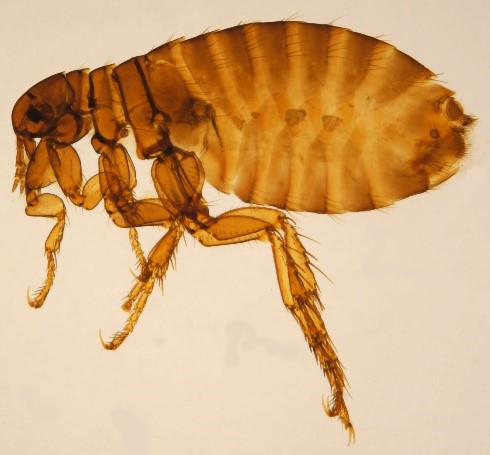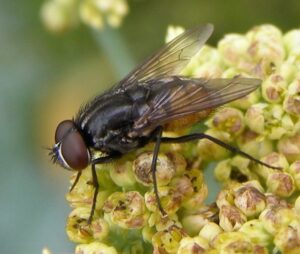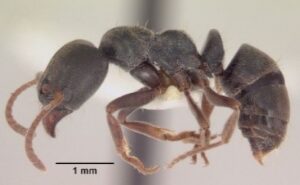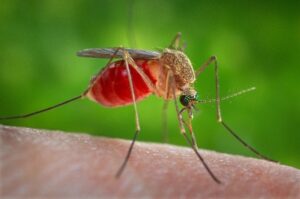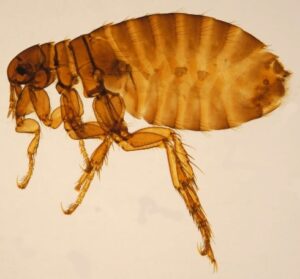
Fleas follow a small order of insects called Siphonaptera. All members of this order have piercing-sucking mouthparts, and people in their homes and businesses are greatly concerned about the flea bites. The number of known flea species is estimated at about 2,500, a few of which are considered pests for humans, and the rest parasitize rodents (74% of them) and birds (6%). Although most species have their favorite hosts, this does not prevent many of them from taking blood meals from different animals, and they may attack humans vigorously in the absence of their preferred host.
Fleas prefer to live on one or two hosts and are therefore not highly specialized in hosts. Fleas require blood for all biological functions. In addition to being a nuisance pest, they are a public health concern, causing skin irritations and spreading some devastating diseases.
Humans react differently after being bitten by fleas, from minor discomfort to severe irritation or skin lesions. In addition to disease transmission, fleas can cause anemia in puppies and kittens. A single bite can cause a reaction in a sensitive animal. Economically, people spent money on flea shampoos, collars, pet medicines, flea sprays, and home remedies.
The oriental rat flea (Xenopsylla cheopis) was responsible for spreading the bubonic plague from rat to rat, and then from rat to humans. Other flea species are known to transmit murine typhus, tapeworms, and other plague bacteria. The majority of flea cases in buildings and on our pets are attributable to the cat flea (Ctenocephalides felis), which is the most common flea found in homes, on cats and dogs, and on many other wildlife species), followed by the human flea (Pulex irritans), and then the dog flea (Ctenocephalides canis). In fact, the cat flea is the most common flea found in homes, on cats and dogs, and on many other wildlife species (responsible for flea infestations in buildings without pets).
ETS inspects your home or business thoroughly and detects all stages of fleas. Our comprehensive management plan includes advanced technology and methods to keep your property flea-free.
The most important fleas closely related to the health of humans and domestic animals are:
- Human flea – Pulex irritans Linneaus – (Pulicidae: Siphonaptera)
- Oriental rat flea – Xenopsylla cheopis Rothschild – (Pulicidae: Siphonaptera)
- Dog flea – Ctenocephalides canis (Curtis) – (Pulicidae: Siphonaptera)
- Cat flea – Ctenocephalides felis (Bouché) – (Pulicidae: Siphonaptera)
- Sticktight flea – Echidnophaga gallinacea Westwood – (Pulicidae: Siphonaptera)
- Burrowing flea – Tunga penetrans (Linneaus) – (Pulicidae: Siphonaptera)
All flea species have similar general descriptions, life cycles, common characteristics, damage, and medical implications.
General Description (click here)
Life Cycle and Common Characteristics (click here)
Damage and Medical Implications (click here)
General Description
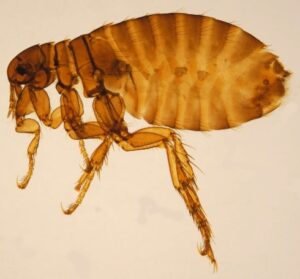
Credit: Katja ZSM Pulex irritans Linneaus Human flea |
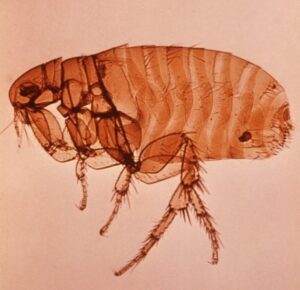
Credit: CDC/WHO Xenopsylla cheopis Rothschild Oriental rat flea |
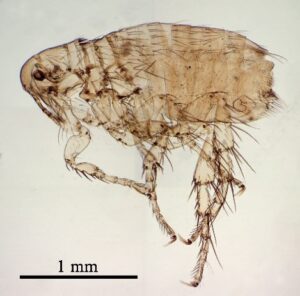
Credit: Luis Fernandez Garcea Ctenocephalides canis (Curtis) Dog flea |
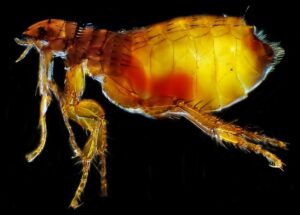
Credit: Andrei Savitsky Ctenocephalides felis (Bouché) Cat flea |

Echidnophaga gallinacea Westwood Sticktight flea |
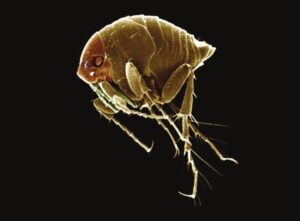
Tunga penetrans (Linneaus) Burrowing flea |
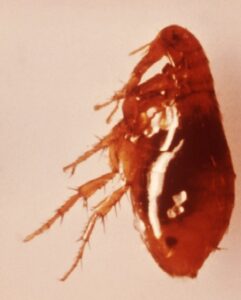
- Fleas are small, wingless insects, 1.5-3.5 mm long. They are brown to reddish-brown in color.
- The body is compressed from both sides, and on each of its rings there are rows of thorns (strong bristles) facing backward to make it easier for them to roam and move forward between animal hair, bird feathers, or between human clothes, as well as making it easier for pests to try to catch them.
- The head is small, with simple eyes and small antennae hidden in a cavity in the head behind the eye.

- The third pair of legs are long, strong, and mutated to jump long distances of up to 20 cm in the vertical direction and about 35 cm in the horizontal direction.
- The egg is large in size and can be seen with the naked eye and has an oval shape that tends to be round, its color is white and it has a smooth shell.
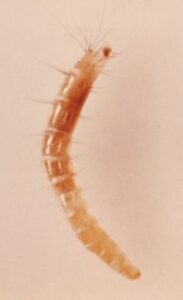
- The larva is small in size, ad its body is divided into 13 rings. It has no legs and a brown head, no eyes, and biting mouthparts. The rest of the body is white.
- Body rings are provided with strong spines and have a pair of fine hooks above the last body ring.
- When the larva is fully developed, it spins a silky cocoon and turns into a pupal.
- The cocoon sticks to grains of sand, soil, food waste, or nearby fabrics.
Life cycle and common characteristics

- The fertilized female flea lays eggs in groups ranging between 15-20 eggs per group on the host after feeding on a blood meal.
- Eggs are laid on dust and dirt or under neglected carpets and beds and in the dwellings of their animal hosts such as cats and dogs, and on the feathers and hair of the host, where they soon fall to the ground.
- The eggs hatch after a period that varies according to the air temperature and ranges from 2-14 days.
- The larvae feed on organic waste, their skins, and the feces of whole fleas, which is an important part of the larvae’s diet.
- The larva molts 3 times and develops after 1-2 weeks, depending on the temperature and humidity, and reaches a length of about 2.5 mm.
- The larval stage may last for several months, and when its growth is complete, it weaves a cocoon from its salivary glands to establish itself in it.
- The pupal period takes between 1-6 weeks.
- The adult stays inside the cocoon until it receives a signal that there is a host nearby through the vibrations and sounds caused by the host’s movements.
- The larvae avoid the light, and therefore they are found hiding after hatching in the dust under carpets and mats, or found in the basal part of the pile of carpets and rugs.
- The pupa turns into a full insect within 1-2 weeks and can last more than a year in conditions that are not suitable for development.
- The female needs a full-blood meal before laying eggs.
- Fleas can generally stay without food for several months, which explains why they are in abandoned rooms or dwellings, or in homes that their owners return to after a short journey. And the movement of the population and the increase in the percentage of carbon dioxide produced from them prompts the fleas to come out of the dormant period and attack them.
- The reproduction of fleas increases in warm, humid climates, and the presence of dust helps them to reproduce, as it is the most suitable place for laying eggs and growing larvae.
- The density of flea stages is ideally distributed in their living places, where eggs constitute 50%, larvae 35%, pupae 15%, and adults 5%.
- The life cycle of a flea can take up to 2 weeks and can be as long as months.
- The female flea lives for several months and may reach a year.
Damage and Medical Implications
The sensitivity of the host’s body to fleas
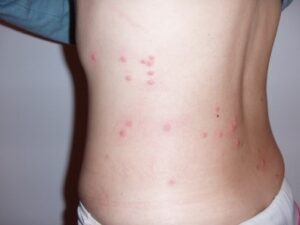
- Fleas attack warm-blooded vertebrates, and the bite of most types of fleas causes great pain and discomfort to humans and may cause skin rashes and small tumors for some people, and fleas also cause red, slightly swollen spots on the skin with a hole in the center of the spot, where flea saliva contains allergens and causes redness of the skin.
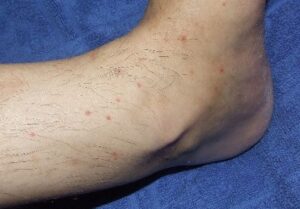
- The high infestation of fleas causes a great loss of blood due to the fleas’ gluttony in feeding. The flea usually bites 3 consecutive bites in the places to which it is attached on the body.
- Flea bites on animals cause hair loss due to the animal scratching the biting places.
Diseases transmitted by fleas
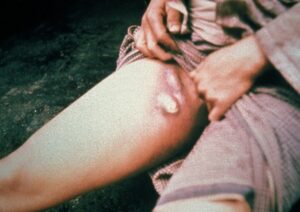
- The flea transmits the most dangerous disease known to mankind, which has led to the lives of millions of people, and it is the plague disease (called the black death disease), which is caused by the bacteria Yersinia pestis, and it is one of the most important diseases transmitted by the rat flea when it feeds on infected rats and then moves on to feed. on the human. The common form of the disease is cutaneous or furuncular. After 2-7 days of infection, the patient’s temperature rises, he feels headaches and bloating, and loses his appetite to eat, accompanied by nausea, vomiting, diarrhea, and confusion of thinking. After that, swelling of the lymph glands begins in the pelvic area, under the armpits, and in the neck. The lung may be infected with the disease, and then it is called the pneumonic plague, as it is accompanied by coughing, sneezing, and rapid breathing.
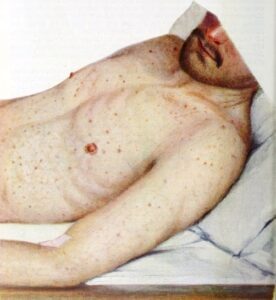
- Fleas also transmit the worldwide spread of typhus fever, which previously wiped out 13 million people in India at the beginning of this century, and the infection is still around 20 cases per 100,000 people per year. This disease is caused by the bacteria called Rickettsia typhi, which is transmitted from rats to humans by fleas. Fleas transmit rabbit fever (Tularemia) and some tapeworms and salmonella bacteria that cause food poisoning, as they cause acute intestinal inflammation and may lead to death in severe cases.

